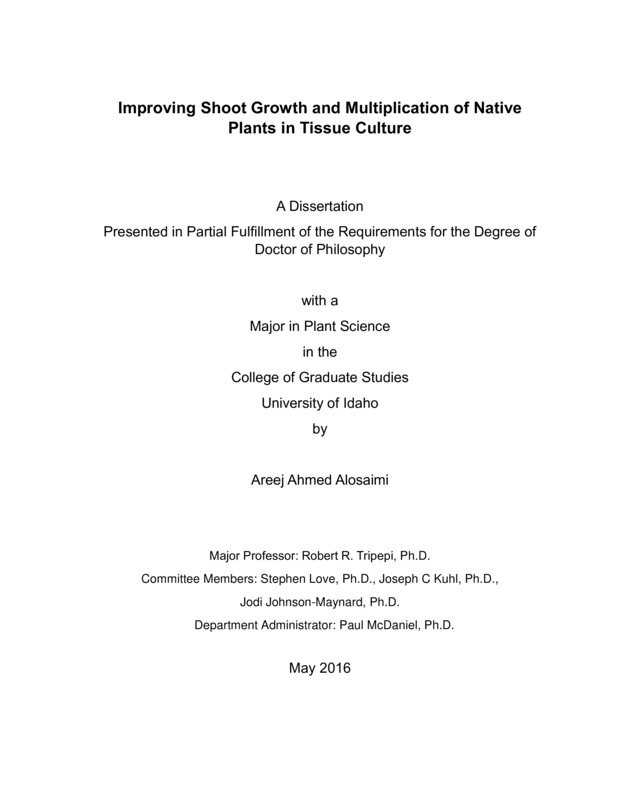Improving Shoot Growth and Multiplication of Native Plants in Tissue Culture
Alosaimi, Areej Ahmed. (2016). Improving Shoot Growth and Multiplication of Native Plants in Tissue Culture. Theses and Dissertations Collection, University of Idaho Library Digital Collections. https://www.lib.uidaho.edu/digital/etd/items/alosaimi_idaho_0089e_10826.html
- Title:
- Improving Shoot Growth and Multiplication of Native Plants in Tissue Culture
- Author:
- Alosaimi, Areej Ahmed
- Date:
- 2016
- Embargo Remove Date:
- 2016-11-19
- Keywords:
- Amelanchier alnifolia Epilobium canum garrettii explants meta-topolin (mT) Micropropagation multiplication
- Program:
- Plant, Soil and Entomological Sciences
- Subject Category:
- Plant sciences
- Abstract:
-
Propagation techniques have been developed for successful production of native plants with commercial value as plant materials for managed landscapes. Shoots of serviceberry, Amelanchier alnifolia Nutt., propagated in tissue culture often fail to form roots readily. In vitro cultured shoots from a selected dwarf plant were examined for their ability to form roots when the basal salt concentration was adjusted or different plant growth regulators were used in the MS medium. The best rooting was achieved with 10 μM IBA or 10 μM NAA, and the percentage of shoots forming roots was 33% for IBA-treated and 67% for NAA-treated shoots. The percentage of rooting increased to 87% on ½ MS medium supplemented with 0.5 μM IBA with 1.6 mg l-1 thiamine and 150 mg l-1 FeEDDHA. Optimizing shoot multiplication media by adding mesos compounds (CaCl2, KH2PO4 and MgSO4) to improve serviceberry shoot quality before root formation helped to increase rooting percentage to 100%. Adjusting mineral concentrations in Murashige and Skoog (MS) medium by adding mesos components in different concentrations increased shoot growth including overall quality, leaf color, shoot multiplication, shoot dry weight and shoot height. The best treatments were 0.132, 0.054, and 0.204 g l-1 or 0.398, 0.054, and 0.102 g l-1 for CaCl2, KH2PO4 and MgSO4, respectively, added to MS medium. These treatments increased the number of shoots per explant by 67% and 43%, shoot height by 91% and 112%, and shoot dry weight by 44% and 77%, respectively, compared to the control shoots. Improving shoot quality for serviceberry helped to increase the rooting percentage, and the shoots established in ex vitro conditions. Epilobium canum garrettii or firechalice was established in tissue culture on Murashige and Skoog medium supplemented with 4.4 μM benzyladenine (BA) in Stage I. During Stage ІІ, different cytokinins, such as BA, kinetin (kin), 6-(γ,γ-dimethlyallylamino)purine (2iP), thidiazuron (TDZ) and meta-topolin (mT), at concentrations of 1.1, 2.2, 4.4 or 8.8 μM were evaluated for axillary shoot proliferation efficacy. The highest number of shoots were formed (11.1 or 15) by using the highest concentration (8.8 μM) of BA or meta-topolin, respectively. In Stage III, firechalice rooted easily without auxin added to the medium, yet 0 to 9 μM IBA can be used during Stage III. Overall, 82.5% of the rooted shoots survived in Stage IV when 0 to 9 μM IBA was used in Stage III. The micropropagation protocol developed for firechalice allows large numbers of plantlets to be produced from one stock plant in relatively a short period of time. Plant improvement and micropropagation through tissue culture have an impact on the landscape plant market since a large number of these plants can be produced quickly for release to the public. Now many plants can be produced and used in the nursery and landscape trade.
- Description:
- doctoral, Ph.D., Plant, Soil and Entomological Sciences -- University of Idaho - College of Graduate Studies, 2016
- Major Professor:
- Tripepi, Robert R
- Committee:
- Love, Stephen; Kuhl, Joseph C; Maynard, Jodi Johnson
- Defense Date:
- 2016
- Identifier:
- Alosaimi_idaho_0089E_10826
- Type:
- Text
- Format Original:
- Format:
- application/pdf
- Rights:
- In Copyright - Educational Use Permitted. For more information, please contact University of Idaho Library Special Collections and Archives Department at libspec@uidaho.edu.
- Standardized Rights:
- http://rightsstatements.org/vocab/InC-EDU/1.0/

